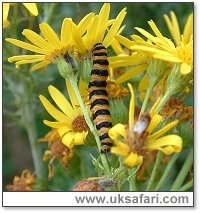
|

|
|
 Sent
to you Sent
to you
by e-mail
|
|
Simply
enter your details and hit the send button
more
info |
|


Click Here

Links
Advertise
Terms of Use
Contributors
About Us
Contact Us
|
 |
Go back
 | Bookmark
| Bookmark
 | Print Page
| Print Page  | E-Mail Us
| E-Mail Us 
How to Control Ragwort

Photo: G. Bradley
|
|
UK
Safari Tip:
A great way to see all the details on these caterpillars and other small
creatures is with a special magnifier box - click
here
|
|
1) Manual Control of Ragwort
Pulling the ragwort plants out by hand will clean the grass crop but it needs to be done out over a number of seasons. Hand pulling can be hazardous to humans too. Protective clothing should be worn to prevent jaundice.
2) Mechanical Control of Ragwort
Cutting the plants before flowering reduces the production of seeds, but it won't destroy the plant. Cut plants left in the field remain a danger to grazing animals, so they need to be removed and burnt.
3) Chemical Control of Ragwort
No single herbicide will totally eliminate ragwort because of the biennial nature of the plant. It can be suppressed by spraying with a glyphosate once a year in the summer.
4) Biological Control of Ragwort
Ragwort is the favoured food plant of Cinnabar moth caterpillars. The Cinnabar Moth is an attractive red and black, day-flying moth, whose yellow and black striped larvae
(above) are dependant on the leaves of ragwort. They can strip a plant within a few days.

UK Safari Ragwort Page
UK Safari Moth Section
|
 |

|